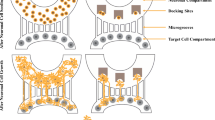Abstract
Axonal pathology has been clearly implicated in neurodegenerative diseases making the compartmental culture of neurons a useful research tool. Primary neurons have already been cultured in compartmental microfluidic devices but their derivation from an animal is a time-consuming and difficult work and has a limit in their sources. Embryonic stem cell (ESC)-derived neurons (ESC_Ns) overcome this limit, since ESCs can be renewed without limit and can be differentiated into ESC_Ns by robust and reproducible protocols. In this research, ESC_Ns were derived from mouse ESCs in compartmental microfluidic devices, and their axons were isolated from the somal cell bodies. Once embryoid bodies (EBs) were localized in the microfluidic culture chamber, ESC_Ns spread out from the EBs and occupied the cell culture chamber. Their axons traversed the microchannels and finally were isolated from the somata, providing an arrangement comparable to dissociated primary neurons. This ESC_N compartmental microfluidic culture system not only offers a substitute for the primary neuron counterpart system but also makes it possible to make comparisons between the two systems.





Similar content being viewed by others
References
Bain G, Kitchens D, Yao M et al (1995) Embryonic stem cells express neuronal properties in vitro. Dev Biol 168:342–357
Beal MF (1995) Aging, energy, and oxidative stress in neurodegenerative diseases. Ann Neurol 38:357–366
Beal MF, Hyman BT, Koroshetz W (1993) Do defects in mitochondrial energy metabolism underlie the pathology of neurodegenerative diseases? Trends Neurosci 16:125–231
Bertrand J, Winton MJ, Rodriguez-Hernandez N et al (2005) Application of Rho antagonist to neuronal cell bodies promotes neurite growth in compartmented cultures and regeneration of retinal ganglion cell axons in the optic nerve of adult rats. J Neurosci 25:1113–1121
Bowling AC, Beal MF (1995) Bioenergetic and oxidative stress in neurodegenerative diseases. Life Sci 56:1151–1171
Brüstle O, Jones KN, Learish RD et al (1999) Embryonic stem cell-derived glial precursors: a source of myelinating transplants. Science 285:754–756
Dang SM, Kyba M, Perlingeiro R et al (2002) Efficiency of embryoid body formation and hematopoietic development from embryonic stem cells in different culture systems. Biotechnol Bioeng 78:442–453
Deacon T, Dinsmore J, Costantini LC et al (1998) Blastula-stage stem cells can differentiate into dopaminergic and serotonergic neurons after transplantation. Exp Neurol 149:28–41
Hayashi H, Campenot RB, Vance DE et al (2004) Glial lipoproteins stimulate axon growth of central nervous system neurons in compartmented cultures. J Biol Chem 279:14009–14015
Keller G, Kennedy M, Papayannopoulou T et al (1993) Hematopoietic commitment during embryonic stem cell differentiation in culture. Mol Cell Biol 13:473–486
Leathy A, Xiong JW, Kuhnert F, Stuhlmann HJ (1999) Use of developmental marker genes to define temporal and spatial patterns of differentiation during embryoid body formation. J Exp Zool 284:67–81
Lee SH, Lumelsky N, Studer L et al (2000) Efficient generation of midbrain and hindbrain neurons from mouse embryonic stem cells. Nat Biotechnol 18:675–679
McKerracher L (2001) Spinal cord repair: strategies to promote axon regeneration. Neurobiol Dis 8:11–18
Medana IM, Esiri MM et al (2003) Axonal damage: a key predictor of outcome in human CNS diseases. Brain 126:515–530
Ng ES, Davis RP, Azzola L et al (2005) Forced aggregation of defined numbers of human embryonic stem cells into embryoid bodies fosters robust, reproducible hematopoietic differentiation. Blood 106:1601–1603
Okabe S, Forsberg-Nilsson K, Spiro AC et al (1996) Development of neuronal precursor cells and functional postmitotic neurons from embryonic stem cells in vitro. Mech Dev 59:89–102
O’Shea KS (2002) Neural differentiation of embryonic stem cells. Methods Mol Biol 198:3–14
Risau W, Sariola H, Zerwes HG et al (1988) Vasculogenesis and angiogenesis in embryonic-stem-cell-derived embryoid bodies. Development 102:471–478
Salehi A, Delcroix JD, Mobley WC (2003) Traffic at the intersection of neurotrophic factor signaling and neurodegeneration. Trends Neurosci 26:73–80
Smith AG et al (2001) Embryo-derived stem cells: of mice and men. Annu Rev Cell Dev Biol 17:435–462
Swerdlow RH, Parks JK, Miller SW et al (1996) Origin and functional consequences of the complex I defect in Parkinson’s disease. Ann Neurol 40:663–671
Taylor AM, Rhee SW, Tu CH et al (2003) Microfluidic multicompartment device for neuroscience research. Langmuir 19:1551–1556
Terry RD, Masliah E, Salmon DP et al (1991) Physical basis of cognitive alterations in Alzheimer’s disease: synapse loss is the major correlate of cognitive impairment. Ann Neurol 30:572–580
Trushina E, McMurray CT (2007) Oxidative stress and mitochondrial dysfunction in neurodegenerative diseases. Neuroscience 145:1233–1248
Wichterle H, Lieberam I, Porter JA et al (2002) Directed differentiation of embryonic stem cells into motor neurons. Cell 110(3):385–397
Acknowledgment
This study was supported by a research fund from National Research Foundation of Korea (No. 2009-0065628).
Author information
Authors and Affiliations
Corresponding authors
Rights and permissions
About this article
Cite this article
Shin, H.S., Kim, H.J., Min, S.K. et al. Compartmental culture of embryonic stem cell-derived neurons in microfluidic devices for use in axonal biology. Biotechnol Lett 32, 1063–1070 (2010). https://doi.org/10.1007/s10529-010-0280-2
Received:
Accepted:
Published:
Issue Date:
DOI: https://doi.org/10.1007/s10529-010-0280-2




